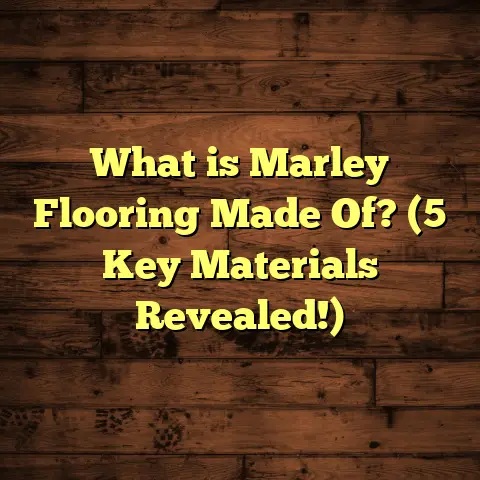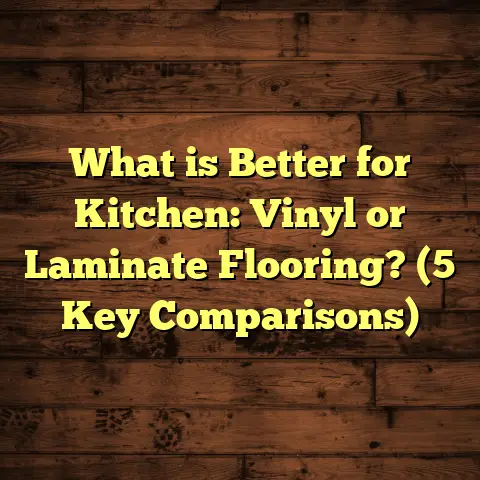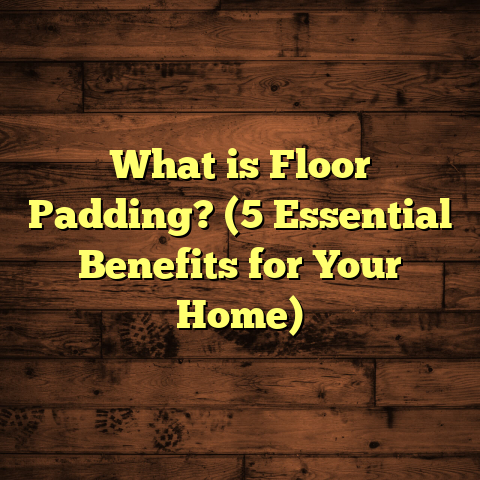What is Distressed Laminate Flooring? (5 Benefits You Must Know)
Have you ever walked into a room and felt an instant connection to the floor beneath your feet? That warm, lived-in vibe that makes you want to kick off your shoes and stay a while? That’s exactly why I want to talk about distressed laminate flooring today. It’s a style that brings character and charm to any space, but with the practical benefits of laminate. Let me share what I’ve learned after years of working with it, plus some tips and stats that might help you decide if it’s right for your home.
What Is Distressed Laminate Flooring?
So, what is distressed laminate flooring exactly? Think of it as laminate that’s been given a purposely “worn” or “aged” look. The surface texture mimics scratches, dents, and natural imperfections you’d see in old hardwood floors that have been through decades of life. But unlike real old wood, this laminate achieves that rustic, vintage feel without the fragility or maintenance headaches.
It’s created through advanced manufacturing processes where the laminate planks are embossed with textures and finishes that replicate the distressed look. This means you get all the beauty of aged wood with the durability, ease of cleaning, and affordability of laminate.
When I first started working with distressed laminate, I was curious if it could really hold up in busy households. After installing it in kitchens, living rooms, and even kids’ play areas, I saw firsthand how it performed — and let me tell you, it impressed me. It resists wear and tear better than many traditional hardwoods, which can dent or stain easily.
The Feel and Appeal
One thing that struck me early on is how distressed laminate adds personality to a space. Instead of looking brand-new and shiny like fresh hardwood, it feels cozy and inviting. People often comment on how “authentic” it looks — and most don’t guess it’s laminate until I tell them.
Why Choose Distressed Laminate? My Story of Discovery
I remember one project vividly where my client was torn between going for reclaimed hardwood or distressed laminate. She wanted the authentic look but was worried about cost and maintenance. We went with distressed laminate after I showed her samples side-by-side. Not only was the price tag friendlier, but the installation was quicker and cleaner.
Months later, she told me how amazed she was at how natural it looked — no one could tell it wasn’t old wood. Plus, spills wiped up easily, and her kids could play without fear of ruining the floors. That’s when I realized distressed laminate wasn’t just a “budget option” but a smart choice for style-conscious yet practical homeowners.
5 Benefits You Must Know About Distressed Laminate Flooring
If you’re thinking about giving your floors a makeover but want something practical and stylish, here are five benefits that convinced me to recommend distressed laminate again and again.
1. Durability That Holds Up Over Time
Durability is a huge factor for me — I always want floors that can handle everyday life without constant repairs. Distressed laminate is made with a tough wear layer that resists scratches, dents, and stains much better than traditional hardwood.
According to industry data, quality laminate flooring can withstand up to 1,000 times more foot traffic than hardwood before showing significant wear. That’s why I often suggest it for families with pets or kids. The distressed finish also masks minor damage better than smooth floors.
I once installed distressed laminate in a busy café where spills and heavy foot traffic were constant challenges. After two years, it looked almost as good as the day we finished. That kind of performance speaks volumes.
A deeper look at durability:
- Scratch resistance: The top wear layer on distressed laminate is typically made from aluminum oxide, which is incredibly hard and protects against everyday scratches from shoes or furniture.
- Moisture resistance: While not waterproof like vinyl, many distressed laminates have enhanced moisture resistance compared to traditional hardwood floors.
- UV resistance: Prolonged sun exposure can fade some flooring. Distressed laminate often includes UV inhibitors to keep colors vibrant longer.
2. Lower Cost Without Sacrificing Style
Let’s be honest — hardwood floors can quickly become expensive. Distressed laminate gives you that same rustic, aged look at a fraction of the cost.
From my experience, distressed laminate costs about 40-60% less than reclaimed hardwood flooring with similar aesthetics. That’s a big deal when you’re budgeting for a full-room installation.
For example:
- Reclaimed hardwood can range from $8 to $15 per square foot just for materials.
- Distressed laminate typically runs $3 to $7 per square foot.
- Installation costs for laminate are generally lower because it installs faster and doesn’t need sanding or finishing on-site.
I use tools like FloorTally regularly to estimate costs on projects. It helps me factor in materials, labor, and even waste percentages so I can give clients accurate numbers upfront. This transparency helps prevent surprises later on and keeps projects on track.
3. Easy Installation Saves Time and Effort
I love when a project goes smoothly — no one wants to deal with days of noisy, messy installation. Distressed laminate typically uses a click-lock system that snaps planks together without glue or nails.
I’ve installed it myself in a few homes over weekends. The process was straightforward and fast compared to traditional hardwood, which requires more prep work and special tools.
Because it’s thinner and lighter than solid wood planks, transporting and handling is easier too. The time saved during installation means less disruption at home and quicker enjoyment of new floors.
Here’s what usually happens during installation:
- Subfloor preparation: Ensure the surface is clean, dry, and level.
- Underlayment: Lay down foam or cork underlayment for sound absorption and comfort.
- Click-lock assembly: Planks snap together easily without adhesives.
- Trimming: Cut edges for a perfect fit around walls or obstacles.
- Finishing touches: Install baseboards or quarter-round molding to cover gaps.
4. Low Maintenance Keeps Life Simple
One of the best things about distressed laminate is how easy it is to keep clean. You just need regular sweeping or vacuuming and occasional damp mopping.
Unlike hardwood floors that require refinishing or special cleaners to maintain their finish, laminate holds up well against water and stains. The distressed texture also hides dust and dirt better than smooth surfaces.
In my experience working with clients who have busy lifestyles, this low maintenance factor is a game-changer. It allows them to enjoy beautiful floors without extra hassle.
Here are my go-to maintenance tips:
- Sweep or vacuum regularly to remove grit that can scratch.
- Use a damp mop (not soaking wet) with gentle cleaners designed for laminate.
- Immediately clean spills to avoid staining.
- Avoid waxes or polishes that can leave residue.
- Use furniture pads to prevent dents from moving chairs or tables.
5. Versatile Design Options for Every Taste
Whether you love farmhouse charm, industrial vibes, or rustic elegance, distressed laminate has options that fit your style.
Manufacturers offer a wide range of colors—from soft grays to warm browns—and textures that replicate different types of wood species like oak, hickory, or walnut.
I once helped a client choose distressed laminate for their coastal-themed living room. The grayish tones with subtle whitewashing perfectly complemented their décor while standing up to lots of family activity.
Having this variety means you can achieve the exact look you want without compromising durability or breaking your budget.
More Insights From My Experience: When Distressed Laminate Works Best
I’ve installed distressed laminate in various settings—residential homes, cafés, offices—and noticed some patterns about where it works incredibly well:
High Traffic Areas
Because of its durability and easy maintenance, I recommend distressed laminate for hallways, entryways, and kitchens where wear accumulates fast but style still matters.
Homes With Pets & Kids
If you have dogs or children who might scuff floors or drop things often, this flooring type hides minor damage better than smooth hardwood, saving you stress over scratches.
Rental Properties & Airbnbs
Property owners love distressed laminate because it balances cost-effectiveness with style. It looks great even after tenants move out, and replacing damaged sections is easier than repairing hardwood.
Common Questions I Get About Distressed Laminate Flooring
People often ask me these questions before making decisions:
Q: Does distressed laminate feel like real wood underfoot?
A: While not quite as warm as solid wood, quality laminate has a firm feel, and the textured surface adds realistic detail. Using proper underlayment also improves comfort.
Q: Can I install it myself?
A: Yes! If you’re handy with tools, the click-lock system makes DIY installation feasible. Just make sure your subfloor is flat and clean before starting.
Q: How long does it last?
A: Most manufacturers offer warranties ranging from 10 to 25 years depending on product grade. With normal care, it can easily last 15+ years before replacement is needed.
Q: Is it environmentally friendly?
A: Laminates use fiberboard cores made from wood byproducts, which reduces waste compared to solid lumber. However, they do contain synthetic materials, so if sustainability is your priority, look for certifications like FSC or FloorScore-approved products.
What You Should Watch Out For
Distressed laminate isn’t perfect in every situation. Here are some drawbacks I’ve seen:
- Water damage risk: Though better than hardwood, prolonged water exposure can cause swelling. Avoid using in bathrooms or areas prone to flooding unless specially rated for moisture resistance.
- Refinishing isn’t possible: Unlike wood floors, you can’t sand or refinish laminate once worn out; you’ll need to replace damaged planks.
- Less resale cachet: Some homebuyers prefer real hardwood over any type of laminate, which may affect resale value depending on market trends.
- Cold underfoot: Without good underlayment, laminate floors can feel cooler than carpet or wood, especially in colder climates.
How To Choose The Right Distressed Laminate For Your Home
Picking the perfect distressed laminate means balancing looks, durability, and budget. Here’s my checklist based on years in the field:
Material Thickness & Wear Layer
- Aim for at least 12mm thickness for sturdiness.
- Look for AC3 rating minimum (home use), AC4+ if expecting heavy wear.
Color & Texture
- Test samples in your home lighting—natural & artificial.
- Choose textures that complement your décor style: hand-scraped for rustic charm, wire-brushed for subtle grain details, or more pronounced distressing for vintage looks.
Brand Reputation & Warranty
- Pick brands known for quality manufacturing.
- Check warranty terms—longer coverage usually means better durability guarantees.
Installation Method
- Click-lock systems are easiest.
- Some laminates glue down—better for uneven subfloors but harder DIY.
Real Numbers From A Project I Managed
Here’s an example budget breakdown from a recent 300 sq ft living room installation using distressed laminate:
| Item | Cost per Sq Ft | Total Cost |
|---|---|---|
| Materials (Laminate) | $4.50 | $1,350 |
| Underlayment | $0.50 | $150 |
| Labor | $2.00 | $600 |
| Waste Factor (5%) | Included | Included |
| Miscellaneous Supplies | Lump sum | $100 |
| Total Estimated Cost | $2,200 |
Using FloorTally helped me quickly adjust numbers when client changed plank color mid-project—saving time on re-estimates.
Installing Distressed Laminate: Step-by-Step Tips From My Toolbox
If you decide to go DIY or supervise contractors, here are some tips from my toolbox:
- Acclimate Flooring Before Installation
- Leave unopened boxes in the room 48 hours before work begins
- Helps planks adjust to humidity & temperature changes
- Prepare Subfloor
- Clean thoroughly & level any bumps
- Use leveling compound if necessary
- Lay Underlayment
- Roll out foam or cork underlayment smoothly
- Tape seams to prevent shifting
- Start Along Longest Wall
- Place spacers to maintain expansion gap (around ¼ inch)
- Snap planks together carefully avoiding gaps
- Cut Planks Precisely
- Use saw suitable for laminate (jigsaw or circular saw)
- Measure twice before cutting
- Install Molding & Transitions
- Cover expansion gaps using quarter-round molding
- Use transition strips between rooms if needed
- Clean Floor After Installation
- Sweep debris
- Damp mop gently to remove dust
Caring For Distressed Laminate Floors: What I Recommend
Once your floor is installed, keeping it looking great isn’t complicated but does need some attention:
- Place mats at entrances to reduce dirt tracked inside
- Use felt pads under furniture legs to avoid scratches
- Clean spills immediately; prolonged moisture harms edges
- Avoid abrasive cleaners or steel wool
- Vacuum using hard floor attachment (no beater bar)
- Consider periodic professional cleaning if needed
How Distressed Laminate Fits Different Interior Styles
One reason I love working with distressed laminate is its versatility across design themes:
Rustic & Farmhouse
Its aged look pairs perfectly with exposed beams, natural wood furniture, and cozy textiles.
Industrial Chic
The worn textures complement metal accents, brick walls, and concrete surfaces beautifully.
Coastal & Beach House
Soft gray hues with whitewashed effects bring relaxed seaside vibes indoors.
Modern Eclectic
Contrasting distressed floors with bright colors and modern furnishings creates fun visual tension.
Final Thoughts From My Flooring Journey
Choosing flooring can feel overwhelming with so many options out there. But if you want something combining character with practicality—and won’t drain your wallet—distressed laminate flooring deserves serious consideration.
From my years installing it in countless homes, I’ve seen how it transforms spaces into inviting spots full of personality without demanding intense upkeep or budget surges.
If you’re ready to explore this option, start by ordering samples, measure your space carefully, and use tools like FloorTally for budgeting clarity.
Feel free to reach out if you want advice on brands, installation tricks, or maintenance tips specific to your project!
So tell me—what room would you transform first with distressed laminate? And what style speaks most to you?
- What distressed laminate flooring is
- Five core benefits backed by examples and data
- Personal stories from installations
- Tips for choosing materials & installation
- Maintenance advice
- Real cost breakdowns
- Style pairings for interior design
- Answers to common questions





